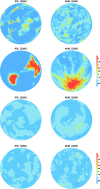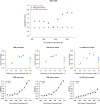Thermodynamic control of anvil cloud amount
- PMID: 27412863
- PMCID: PMC4987798
- DOI: 10.1073/pnas.1601472113
Thermodynamic control of anvil cloud amount
Abstract
General circulation models show that as the surface temperature increases, the convective anvil clouds shrink. By analyzing radiative-convective equilibrium simulations, we show that this behavior is rooted in basic energetic and thermodynamic properties of the atmosphere: As the climate warms, the clouds rise and remain at nearly the same temperature, but find themselves in a more stable atmosphere; this enhanced stability reduces the convective outflow in the upper troposphere and decreases the anvil cloud fraction. By warming the troposphere and increasing the upper-tropospheric stability, the clustering of deep convection also reduces the convective outflow and the anvil cloud fraction. When clouds are radiatively active, this robust coupling between temperature, high clouds, and circulation exerts a positive feedback on convective aggregation and favors the maintenance of strongly aggregated atmospheric states at high temperatures. This stability iris mechanism likely contributes to the narrowing of rainy areas as the climate warms. Whether or not it influences climate sensitivity requires further investigation.
Keywords: anvil cloud; climate sensitivity; cloud feedback; convective aggregation; large-scale circulation.
Conflict of interest statement
The authors declare no conflict of interest.
Figures














Comment in
- 8897
References
-
- Slingo A, Slingo JM. The response of a general circulation model to cloud longwave radiative forcing. i: Introduction and initial experiments. Q J R Meteorol Soc. 1988;114:1027–1062.
-
- Randall DA, Harshvardhan, Dazlich DA, Corsetti TG. Interactions among radiation, convection, and large-scale dynamics in a general circulation model. J Atmos Sci. 1989;46:1943–1970.
-
- Sherwood SC, Ramanathan V, Barnett TP, Tyree MK, Roeckner E. Response of an atmospheric general circulation model to radiative forcing of tropical clouds. J Geophys Res. 1994;99:20829–20845.
-
- Bony S, et al. Clouds, circulation and climate sensitivity. Nat Geosci. 2015;8:261–268.
-
- Voigt A, Shaw TA. Circulation response to warming shaped by radiative changes of clouds and water vapour. Nat Geosci. 2015;8:102–106.
Publication types
LinkOut - more resources
Full Text Sources
Other Literature Sources
Research Materials

